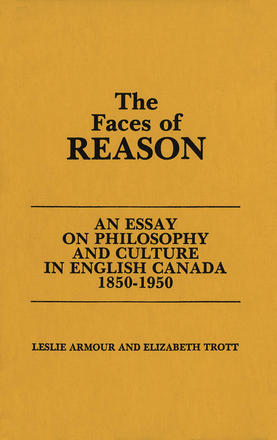
The Faces of Reason
An Essay on Philosophy and Culture in English Canada1850-1950
Description
The Faces of Reason traces the history of philosophy in English Canada from 1850 to 1950, examining the major English-Canadian philosophers in detail adn setting them in the context of the main currents of Canadian thought. The book concludes with a brief survey of the period after 1950.
What is distinctive in Canadian philosophy, say the authors, is the concept of reason and the uses to which it is put. Reason has interacted with experience in a new world and a cold climate to create a distinctive Canadian community. The diversity of political, geographic, social, and religious factors has fostered a particular kind of thinking, particular ways of reasoning and communicating. Rather than one grand, overarching Canadian way of thinking, there are “many faces of reason,” “a kind of philosophic federalism”.
The book has two dimensions: “it is a continuos story which makes a point about the development of philosophical reason in the Canadian context.... it is a reference work which may be consulted by readers interested in particular figures, ideas, movements, or periods.”
Reviews
An extraordinary document -- the first systematic history of the development of Canadian philosophy from 1850 to 1950.
- Arnold Ages, Toronto Star, May 22, 1982, 2004 December
Faces of Reason is made accessible to readers outside the area of philosophic study by the lucidity and liveliness of the writing....I do not think I have encountered, since Bertrand Russell's History of Western Philosophy, a book in this field so open to the layman interested in the links--within the general cultural ambience--between philosophy and letters.
- George Woodcock, Canadian Literature, 94, Fall 1982, 2004 December
For those interested in Canadian intellectual history, The Faces of Reason is an indispensable work, based on intensive research, written from a unified point of view, and expressed in an accessible style.
- J.T. Stevenson, University of Toronto, Canadian Forum, June/July 1982, 2004 December
Now, The Faces of Reason comes to us with the glowing recommendations of Northrop Frye and George Grant. Frye exclaims, This is the kind of book I have been looking for for a long time.'' It is the kind of book that does for Canadian philosophy what Frye's own The Bush Garden has done for Canadian literature--it opened the mine of a rich deposit of Canadian culture. Grant praises Armour and Trott for providing the first published account of what went on in the teaching of philosophy in Canada which is really carefully and detailedly done.
- Bart Testa, Globe and Mail, October 9, 1982